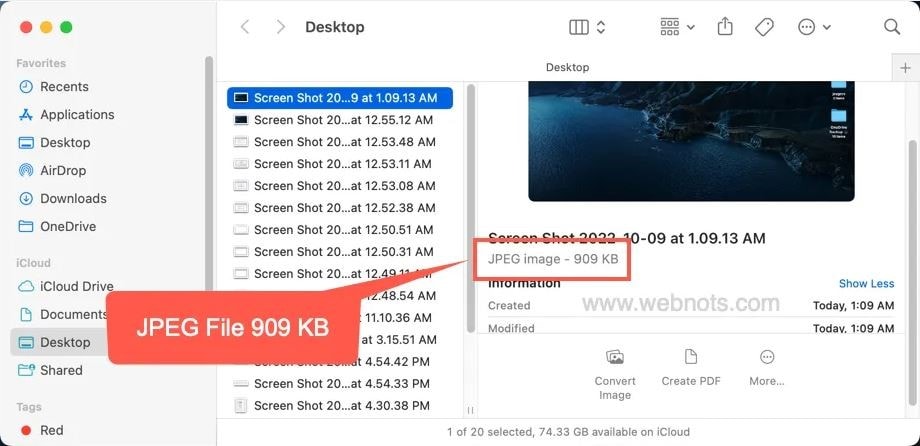Full and Detailed Comparison: HEIF vs. JPEG: Which Is Better
Jul 12, 2024 • Filed to: Manage Device Data • Proven solutions
Image compression formats are essential for effectively storing and sharing digital photographs in the modern world. High-Efficiency Image Format (HEIF) and JPEG (Joint Photographic Experts Group) are extensively used.
HEIF, known for its superior image quality and compression efficiency, offers advantages such as detailed preservation of colors and dynamic range. It also introduces advanced features like transparency and storing multiple images in a single file.
On the other hand, JPEG remains widely supported and compatible across various platforms. By exploring the pros and cons of HEIF vs. JPEG, you can determine the ideal format that aligns with your requirements.
Image compression formats are essential for saving storage space, lowering bandwidth consumption, and maintaining interoperability across devices and applications. It also helps strike the optimal balance between image quality and file size in digital media.
This post provides a full and detailed comparison of HEIF vs. JPEG and explains which one is better for you.
Part 1. Understanding JPEG (Joint Photographic Experts Group)
JPEG is a widely used image compression format. It was developed in the early 1990s and has become the de facto standard for storing and sharing digital images.
Benefits of JPEG
There are multiple benefits associated with the use of JPEG, including:
- Broad Compatibility
JPEG is supported by many devices, software applications, and web browsers, making it highly compatible for viewing and sharing images across various platforms.
- Simple and Established Format
JPEG's simplicity contributes to its widespread adoption. It has a straightforward structure and encoding process, making it easy to implement and work within different software and hardware environments.
- Lossy Compression for Efficient Storage
JPEG utilizes lossy compression, which selectively discards image data that is less visually significant. This compression technique significantly reduces file sizes, allowing for efficient storage and transmission of images.
Limitations of JPEG
With multiple benefits, there are some limitations of JPEG as well, including:
- Loss of Image Quality
Due to its lossy compression method, JPEG sacrifices some image details to achieve smaller file sizes. It can result in a noticeable loss of image quality, particularly in highly compressed images or when repeatedly edited and saved.
- Inability to Store Multiple Images or Non-image Data
JPEG is primarily designed for individual image storage and does not provide native support for storing numerous images or non-image data within a single file.

Part 2: Understanding HEIF (High-Efficiency Image Format)
HEIF is a relatively newer image compression format developed by the Moving Picture Experts Group (MPEG). It was introduced as an improvement over traditional formats like JPEG, aiming to provide higher image quality at smaller file sizes.
Advantages of HEIF over JPEG
In JPEG vs. HEIF comparison, there are multiple benefits of HEIF, including:
- Improved Image Quality With Reduced File Size
HEIF uses High-Efficiency Video Coding (HEVC) to achieve superior image quality compared to JPEG at smaller file sizes.
It means that HEIF can deliver more visually pleasing images while conserving storage space.
- Support for Multiple Images and Non-image Data
Unlike JPEG, HEIF is a versatile container format that can store not only individual photos but also image sequences, image collections, image thumbnails, and even image editing operations.
It allows for more efficient organization and storage of related image data within a single HEIF file.
- Advanced Compression Algorithms
HEIF's use of advanced compression techniques, such as HEVC, enables more efficient compression and improved image details, colors, and dynamic range preservation.
It results in higher fidelity and more accurate representation of images, particularly in cases involving higher color depths or HDR (High Dynamic Range).
- Versatile Container Format
HEIF is not solely limited to storing images.
It can also accommodate other media types, such as audio, text, and depth maps, creating more immersive and interactive experiences.
Supported Devices and Platforms
HEIF has gained significant support since its introduction. Most modern devices, operating systems, and software applications now provide compatibility with HEIF.
It includes iOS, macOS, Windows, Android, and popular image editing software. However, it is worth noting that some older or less standard devices and software may have limited or no support for HEIF.
Understanding the advantages of HEIF can help users make informed decisions regarding adopting and using HEIF in their workflows.
Part 3. Key Differences between HEIF and JPEG
Here are the key differences between JPEG vs. HEIF as we compare these popular image formats.
Compression Algorithms and Techniques
- HEIF:It employs advanced compression algorithms, primarily the HEVC algorithm, which offers superior compression efficiency compared to JPEG. It allows for better image quality at smaller file sizes.
- JPEG:It uses the Discrete Cosine Transform (DCT) algorithm, a well-established method for lossy compression. While effective, HEIF's compression algorithms are more efficient.
Image Quality and Compression Ratios
- HEIF:It generally provides better image quality than JPEG, especially when using the same file size. The advanced compression techniques in HEIF preserve more image details, colors, and dynamic range.
- JPEG:It sacrifices some image details during compression, resulting in a potential loss of image quality, especially in highly compressed images or when repeatedly edited and saved. However, JPEG's compression ratios are generally suitable for smaller file sizes.
Support for Additional Media Types and Features
- HEIF:It supports storing not only images but also additional media types like audio, text, depth maps, and image editing operations. It makes HEIF a versatile container format for various multimedia applications.
- JPEG:It primarily focuses on storing individual images and does not provide native support for storing additional media types or advanced features.
Compatibility and Support across Devices and Software
- HEIF: While HEIF has gained significant support since its introduction, some older or less common devices and software may need more support for HEIF. However, most modern devices, operating systems, and software applications now provide compatibility with HEIF.
- JPEG:It has been the standard image format for a long time and enjoys widespread support across devices, software, and web browsers. It is compatible with virtually all platforms and is widely recognized.
File Size and Storage Considerations
- HEIF:Due to its advanced compression algorithms, HEIF achieves smaller file sizes while maintaining better image quality. It is advantageous for storage space optimization and transmission over networks.
- JPEG:Its compression ratios are generally effective for achieving smaller file sizes, although they may not match the compression efficiency of HEIF. However, the compromise is a potential loss of image quality.
Part 4. Comparison of Use Cases for HEIF and JPEG
Practical use cases are a key factor in determining which format is suitable for you. Here is a comparison of use cases for HEIF vs JPEG.
Photography and Professional Image Editing
For professional photographers and image editing workflows, HEIF offers advantages such as higher image quality and support for advanced features like non-destructive editing.
The ability to store multiple images and additional metadata within a single HEIF file is beneficial for organizing and managing image collections.
JPEG remains a widely used format in the photography industry. It provides good image quality and is supported by many editing software. However, it needs some of the advanced features and superior image quality that HEIF offers.
Web and Online Media
While HEIF support has increased, JPEG is still the dominant web and online media format due to its widespread compatibility.
However, as support for HEIF grows, it offers advantages in smaller file sizes, higher image quality, and support for additional media types.
JPEG is highly compatible across web browsers, making it ideal for web and online media applications. Its compression efficiency and relatively good image quality make it suitable for delivering images quickly over the Internet.
Storage and Archiving
HEIF's superior compression efficiency and support for multiple images make it a compelling choice for storage and archiving purposes. It allows for storing a collection of images in a single file while maintaining high image quality and reducing storage space requirements.
JPEG's broad compatibility and established support make it a reliable option for long-term storage and archiving. While not as efficient as HEIF, its compression ratios still provide reasonable file sizes without significant loss of image quality.
Considering the specific use cases outlined above, it is essential to assess the priorities of image quality, compatibility, advanced features, and storage considerations when choosing between HEIF and JPEG.
HEIF is well-suited for professional photography, advanced editing, and storage/archiving needs. At the same time, JPEG remains a strong choice for web and online media due to its compatibility and established support.
Final Thoughts
HEIF and JPEG are prominent image compression formats with advantages and limitations. HEIF offers superior image quality, smaller file sizes, multiple images and additional media types support, and advanced compression algorithms.
In comparison, JPEG provides widespread compatibility, simplicity, established support, and reasonable compression ratios, although it sacrifices some image quality. When comparing HEIF vs. JPEG, several factors like Image Quality, Compatibility, Use Cases, and Future-proofing should be considered.
The increasing demand for higher image quality and efficient storage will likely drive the adoption of HEIF in various domains, including photography, web, and storage/archiving. However, JPEG's widespread compatibility and established ecosystem ensure its continued relevance in the foreseeable future.
FAQ
FAQs
iPhone Photos
- Convert HEIC to JPG
- 1. Convert HEIC to JPG on Linux
- 2. Convert HEIC to JPG Windows
- 3. Best HEIC Converter Online
- 4. Convert HEIC to JPG High Quality
- Export iPhone Photos
- 1. Upload iPhone Photos to Google Drive
- 2. Transfer Photo from iPhone to PC
- 3. Transfer Photo from iPhone to iPhone
- 4. Transfer from iPhone to iPhone
- 5. Transfer from iPhone to iPad
- 6. Move iPhone Photo to External Drive
- 7. Transfer from iPhone to Flash Drive
- 8. Extract Photos from iPhone
- 9. Download Photo from iPhone
- Import Photos to iPhone
- 1. Transfer from Laptop to iPhone
- 2. Transfer Photo from Camera to iPhone
- 3. Transfer Photo from Mac to iPhone
- 4. Transfer Photos from PC to iPhone
- 5. Transfer from iPhone to PC
- 6. Transfer from Android to iPhone
- 7. Transfer from Samsung to iPhone
- Manage iPhone Photos
- 1. Back up iPhone Photos
- 2. Get Photos off iPhone
- 3. Send Large Size Photos from iPhone
- 4. Photo/Video Compressor Apps
- 5. Delete Photos from iPhone/iPad
- 6. iPhone Photos Disappeared Suddenly
- 7. iPhone Photoshop Alternatives
- Recover iPhone Photos
- 1. Restore Deleted Photos from iPhone
- 2. Recover Photos from iPod Touch
- 3. Recover Deleted Picture from iPhone
- Transfer iPhone Photos to Mac
- Transfer iPhone Photos to PC
- 1. Transfer Data from iPhone to PC
- 2. Transfer Photo to Computer
- 3. Transfer Photo to PC without iTunes
- 4. Transfer Library to Computer
- 5. Send Photo from iPhone to Computer
- 6. Import Photo from iPhone to Windows
- 7. Transfer Photo to Windows
- Transfer Photos from Google Drive
- 1. Download from Google Drive to iPhone
- 2. Transfer from Google Photo to iPhone
- 3. Download from iCloud to iPhone
- Transfer Photos to Google Drive
- Image Convert Tips
- ● Manage/transfer/recover data
- ● Unlock screen/activate/FRP lock
- ● Fix most iOS and Android issues
- Learn More Learn More




James Davis
staff Editor